 Green orchid bees are a quite conspicuous and charismatic species. This is mostly due to their large size and bright metallic-green coloration. They are very fast and agile flyers, and can be seen quickly darting from flower to flower separated by long periods of hovering. Male orchid bees collect fragrant volatile compounds from their environment and present them to females by fanning their wings and “spray ventilating” their bouquet for the inspection of prospective mates. In Florida, male green orchid bees are attracted to chemicals produced by certain wood-rot fungi, decomposing vegetation, perfume flowers, and certain essential oils such as clove and cinnamon oil. Male green orchid bees can be quickly and easily attracted and observed by soaking a small piece of paper with clove oil and placing it outside. This 4-page fact sheet was written by Aaron Mullins, and published by the UF Department of Entomology and Nematology, October 2013.
Green orchid bees are a quite conspicuous and charismatic species. This is mostly due to their large size and bright metallic-green coloration. They are very fast and agile flyers, and can be seen quickly darting from flower to flower separated by long periods of hovering. Male orchid bees collect fragrant volatile compounds from their environment and present them to females by fanning their wings and “spray ventilating” their bouquet for the inspection of prospective mates. In Florida, male green orchid bees are attracted to chemicals produced by certain wood-rot fungi, decomposing vegetation, perfume flowers, and certain essential oils such as clove and cinnamon oil. Male green orchid bees can be quickly and easily attracted and observed by soaking a small piece of paper with clove oil and placing it outside. This 4-page fact sheet was written by Aaron Mullins, and published by the UF Department of Entomology and Nematology, October 2013.
http://edis.ifas.ufl.edu/in1013
Author: dihagan
Cabbage aphid Brevicoryne brassicae Linnaeus (Insecta: Hemiptera: Aphididae)
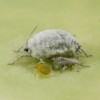 Cabbage aphids cause significant yield losses to many crops of the family Brassicaceae, which includes the mustards and crucifers. It is important to have a comprehensive understanding of this pest and its associated control measures so that its spread and damage can be prevented. This 5-page fact sheet was written by Harsimran Kaur Gill, Harsh Garg, and Jennifer L. Gillett-Kaufman, and published by the UF Department of Entomology and Nematology, October 2013.
Cabbage aphids cause significant yield losses to many crops of the family Brassicaceae, which includes the mustards and crucifers. It is important to have a comprehensive understanding of this pest and its associated control measures so that its spread and damage can be prevented. This 5-page fact sheet was written by Harsimran Kaur Gill, Harsh Garg, and Jennifer L. Gillett-Kaufman, and published by the UF Department of Entomology and Nematology, October 2013.
http://edis.ifas.ufl.edu/in1014
Raising Healthy Children: Shellfish Allergies
 Learning that your child has a shellfish allergy can be scary. But having a plan and knowing how to treat and avoid a reaction to shellfish can ease this fear and keep your child safe. This publication explains shellfish allergies and provides information on the symptoms and how to respond if a reaction occurs. There are also tips to make it easier to manage your child’s shellfish allergy at home and away from home.This 4-page fact sheet was written by Kate Bennett, Karla P. Shelnutt, and Gail P. A. Kauwell, and published by the UF Department of Family Youth and Community Sciences, November 2013.
Learning that your child has a shellfish allergy can be scary. But having a plan and knowing how to treat and avoid a reaction to shellfish can ease this fear and keep your child safe. This publication explains shellfish allergies and provides information on the symptoms and how to respond if a reaction occurs. There are also tips to make it easier to manage your child’s shellfish allergy at home and away from home.This 4-page fact sheet was written by Kate Bennett, Karla P. Shelnutt, and Gail P. A. Kauwell, and published by the UF Department of Family Youth and Community Sciences, November 2013.
http://edis.ifas.ufl.edu/fy1402
Home Gardening Food Safety: Washing the Fruits (and Vegetables) of Your Labor Properly
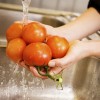 Having a home garden has become popular recently. It is a great way to enjoy fresh fruits and vegetables—foods that are an important part of a healthy diet. However, just because you have your own garden and control how it is treated does not make the fruits and vegetables you grow safer than those you buy in the store. To reduce the chance of getting sick from foodborne illnesses, you must wash the fruits and vegetables you grow before eating them raw or cooked. This publication helps you learn the proper way to clean your fruits and vegetables so you can enjoy them safely. This 4-page fact sheet was written by Eshani Persaud, Amy Simonne, and Karla P. Shelnutt, and published by the UF Department of Family Youth and Community Sciences, November 2013.
Having a home garden has become popular recently. It is a great way to enjoy fresh fruits and vegetables—foods that are an important part of a healthy diet. However, just because you have your own garden and control how it is treated does not make the fruits and vegetables you grow safer than those you buy in the store. To reduce the chance of getting sick from foodborne illnesses, you must wash the fruits and vegetables you grow before eating them raw or cooked. This publication helps you learn the proper way to clean your fruits and vegetables so you can enjoy them safely. This 4-page fact sheet was written by Eshani Persaud, Amy Simonne, and Karla P. Shelnutt, and published by the UF Department of Family Youth and Community Sciences, November 2013.
http://edis.ifas.ufl.edu/fy1401
Washingtonia robusta: Mexican Fan Palm
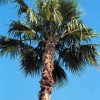 The Mexican fan palm is a fast-growing species that can reach heights of 70 to 100 feet, making it too tall for typical residential landscapes. It is native to northern Mexico but grows well in Florida, being hardy down to about 20°F or USDA hardiness zone 9A. Mexican fan palms grow well in a wide range of soils in Florida, but do require good drainage. Though considered a desert palm, it is native to areas having permanent surface or subsurface water and thus is not as drought tolerant as might be expected. This 5-page fact sheet was written by Timothy K. Broschat, and published by the UF Department of Environmental Horticulture, February 2013.
The Mexican fan palm is a fast-growing species that can reach heights of 70 to 100 feet, making it too tall for typical residential landscapes. It is native to northern Mexico but grows well in Florida, being hardy down to about 20°F or USDA hardiness zone 9A. Mexican fan palms grow well in a wide range of soils in Florida, but do require good drainage. Though considered a desert palm, it is native to areas having permanent surface or subsurface water and thus is not as drought tolerant as might be expected. This 5-page fact sheet was written by Timothy K. Broschat, and published by the UF Department of Environmental Horticulture, February 2013.
http://edis.ifas.ufl.edu/st670
Syagrus romanzoffiana: Queen Palm
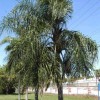 The queen palm is a popular feather-leaved palm with graceful arching leaves. It is one of the hardiest of the tropical-looking palms, being suitable for planting in USDA plant hardiness zone 9B (>25°F). Queen palms are considered to be moderately tolerant of salt spray. This 5-page fact sheet was written by Timothy K. Broschat, and published by the UF Department of Environmental Horticulture, October 2013.
The queen palm is a popular feather-leaved palm with graceful arching leaves. It is one of the hardiest of the tropical-looking palms, being suitable for planting in USDA plant hardiness zone 9B (>25°F). Queen palms are considered to be moderately tolerant of salt spray. This 5-page fact sheet was written by Timothy K. Broschat, and published by the UF Department of Environmental Horticulture, October 2013.
http://edis.ifas.ufl.edu/st609
Florida Master Beekeeper Program Requirements
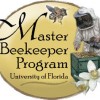 The Master Beekeeper Program (MBP) is a five-year (minimum) beekeeper training and certification program provided by the University of Florida. One must already be a beekeeper to enter the program. This 22-page fact sheet was written by James Ellis, Jerry Hayes, Catherine Zettel Nalen, William H. Kern, Ray Zerba, Brad Burbaugh, and Jeanette Klopchin, and published by the UF Department of Entomology and Nematology, October 2013.
The Master Beekeeper Program (MBP) is a five-year (minimum) beekeeper training and certification program provided by the University of Florida. One must already be a beekeeper to enter the program. This 22-page fact sheet was written by James Ellis, Jerry Hayes, Catherine Zettel Nalen, William H. Kern, Ray Zerba, Brad Burbaugh, and Jeanette Klopchin, and published by the UF Department of Entomology and Nematology, October 2013.
http://edis.ifas.ufl.edu/in847
Ladybird beetles – recent immigrants to Florida (Insecta: Coleoptera: Coccinellidae)
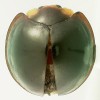 Since the publication of the Florida beetles checklist, a few ladybird beetles have become established in the state, some well-known and extensively documented and some little noticed and previously unreported. It is these latter species that are covered in this publication. All of the listed species are represented by voucher specimens in the Florida State Collection of Arthropods. Species previously known from Florida are reported by Frank and Mizell (2012) with emphasis on natural history. This 5-page fact sheet was written by Michael C. Thomas and Orland J. Blanchard, Jr., and published by the UF Department of Entomology and Nematology, October 2013.
Since the publication of the Florida beetles checklist, a few ladybird beetles have become established in the state, some well-known and extensively documented and some little noticed and previously unreported. It is these latter species that are covered in this publication. All of the listed species are represented by voucher specimens in the Florida State Collection of Arthropods. Species previously known from Florida are reported by Frank and Mizell (2012) with emphasis on natural history. This 5-page fact sheet was written by Michael C. Thomas and Orland J. Blanchard, Jr., and published by the UF Department of Entomology and Nematology, October 2013.
http://edis.ifas.ufl.edu/in1012
Woolly oak aphids Stegophylla brevirostris Quednau and Diphyllaphis microtrema Quednau (Insecta: Hemiptera: Aphididae)
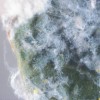 Woolly oak aphids are conspicuous pests on oak, because they are covered with large amounts of flocculent wax. Two genera of woolly oak aphids occur in Florida, each including one known native Florida species. One species, Stegophylla brevirostris Quednau, is common, and the other, Diphyllaphis microtrema Quednau, is rare. This 3-page fact sheet was written by Susan E. Halbert, and published by the UF Department of Entomology and Nematology, October 2013.
Woolly oak aphids are conspicuous pests on oak, because they are covered with large amounts of flocculent wax. Two genera of woolly oak aphids occur in Florida, each including one known native Florida species. One species, Stegophylla brevirostris Quednau, is common, and the other, Diphyllaphis microtrema Quednau, is rare. This 3-page fact sheet was written by Susan E. Halbert, and published by the UF Department of Entomology and Nematology, October 2013.
http://edis.ifas.ufl.edu/in1011
University of Florida Potato Variety Spot Light: Red LaSoda
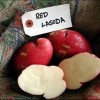 Red LaSoda is the red-skinned fresh-market potato standard for Florida. It was observed in 1949 as a deep red mutant of LaSoda in the Louisiana potato breeding program. It has been in trials over many seasons and at many locations in Florida including university and grower sites. Production and quality results provided in this 4-page fact sheet are summarized from the red-skinned fresh-market trials conducted by the University of Florida over the past 14 seasons. Written by Lincoln Zotarelli, Doug Gergela, Chad M. Hutchinson, David Dinkins, and Edsel Redden, and published by the UF Department of Horticultural Sciences, August 2013.
Red LaSoda is the red-skinned fresh-market potato standard for Florida. It was observed in 1949 as a deep red mutant of LaSoda in the Louisiana potato breeding program. It has been in trials over many seasons and at many locations in Florida including university and grower sites. Production and quality results provided in this 4-page fact sheet are summarized from the red-skinned fresh-market trials conducted by the University of Florida over the past 14 seasons. Written by Lincoln Zotarelli, Doug Gergela, Chad M. Hutchinson, David Dinkins, and Edsel Redden, and published by the UF Department of Horticultural Sciences, August 2013.
http://edis.ifas.ufl.edu/hs323
Florida Edible Garden Plants: Hops (Humulus lupulus)
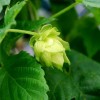 Hops are perennial, herbaceous climbing plants commonly cultivated for their strobiles or cones (Figure 1). The cones are often used for flavoring and aroma in food, tea, and beer (Burgess 1964). Hops can make a unique addition to a home garden or landscape. It grows rapidly in the early spring to late summer. Plants reach a mature height of 18–25 feet in one year and produce cones from mid-summer to early fall. This 2-page fact sheet was written by Brian J. Pearson, and published by the UF Department of Environmental Horticulture, October 2013.
Hops are perennial, herbaceous climbing plants commonly cultivated for their strobiles or cones (Figure 1). The cones are often used for flavoring and aroma in food, tea, and beer (Burgess 1964). Hops can make a unique addition to a home garden or landscape. It grows rapidly in the early spring to late summer. Plants reach a mature height of 18–25 feet in one year and produce cones from mid-summer to early fall. This 2-page fact sheet was written by Brian J. Pearson, and published by the UF Department of Environmental Horticulture, October 2013.
http://edis.ifas.ufl.edu/ep488
The Florida Bull Test 2012-2013
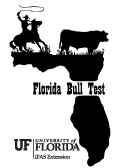 The North Florida Research and Education Center in Marianna, Florida annually hosts the Florida Bull Test. By controlling the environmental factors and taking Expected Progeny Differences (EPD’s) into account, the data clearly emphasizes the dual importance of genetics and environment in all cattle types. This 9-page fact sheet presents the procedures, rules, and results of the 2012-2013 test. Written by G. Cliff Lamb and Nicolas DiLorenzo, and published by the UF Department of Animal Sciences, October 2013.
The North Florida Research and Education Center in Marianna, Florida annually hosts the Florida Bull Test. By controlling the environmental factors and taking Expected Progeny Differences (EPD’s) into account, the data clearly emphasizes the dual importance of genetics and environment in all cattle types. This 9-page fact sheet presents the procedures, rules, and results of the 2012-2013 test. Written by G. Cliff Lamb and Nicolas DiLorenzo, and published by the UF Department of Animal Sciences, October 2013.
http://edis.ifas.ufl.edu/an290
The Facts About Applying: Health Care Coverage and the Affordable Care Act
 President Obama signed the Affordable Care Act into law in March 2010, putting in place a set of reforms to health coverage in the United States. For Americans who have health insurance, they do not have to change their current plan under the health care law. However, those who do not have coverage will have the chance to shop for health insurance starting October 1 using the new Health Insurance Marketplace. This publication reviews some common questions about the new health care law and how it will affect citizens. This 3-page fact sheet was written by Meg McAlpine and Martie Gillen, and published by the UF Department of Family Youth and Community Sciences, October 2013.
President Obama signed the Affordable Care Act into law in March 2010, putting in place a set of reforms to health coverage in the United States. For Americans who have health insurance, they do not have to change their current plan under the health care law. However, those who do not have coverage will have the chance to shop for health insurance starting October 1 using the new Health Insurance Marketplace. This publication reviews some common questions about the new health care law and how it will affect citizens. This 3-page fact sheet was written by Meg McAlpine and Martie Gillen, and published by the UF Department of Family Youth and Community Sciences, October 2013.
http://edis.ifas.ufl.edu/fy1394
Choose MyPlate: Enjoy Your Food But Eat Less
 Americans tend to select and consume larger portions than they need, and they don’t always make the best choices either. Part of the secret to maintaining a healthy diet is to know which foods to select and how to balance your intake with the amount of energy your body uses. This publication provides information about which foods make the healthiest contributions to our diets and which to limit. It also provides tips for making it easier to adjust your portions and to enjoy foods while making adjustments to your plate. This 4-page fact sheet was written by Ashley Hamm, Karla P. Shelnutt, and Gail P. A. Kauwell, and published by the UF Department of Family Youth and Community Sciences, November 2013.
Americans tend to select and consume larger portions than they need, and they don’t always make the best choices either. Part of the secret to maintaining a healthy diet is to know which foods to select and how to balance your intake with the amount of energy your body uses. This publication provides information about which foods make the healthiest contributions to our diets and which to limit. It also provides tips for making it easier to adjust your portions and to enjoy foods while making adjustments to your plate. This 4-page fact sheet was written by Ashley Hamm, Karla P. Shelnutt, and Gail P. A. Kauwell, and published by the UF Department of Family Youth and Community Sciences, November 2013.
http://edis.ifas.ufl.edu/fy1400
Repackaging as a Strategy to Increase Efficiency in Extension Programs
 Repackaging is a way to reuse the research and writing one has done on a particular topic by formatting it in multiple formats for several audiences. It can be used as a strategy to reach a greater variety of audiences with fewer resources. This 3-page fact sheet was written by Laura A. Sanagorski, and published by the UF Department of Agricultural Education and Communication, October 2013.
Repackaging is a way to reuse the research and writing one has done on a particular topic by formatting it in multiple formats for several audiences. It can be used as a strategy to reach a greater variety of audiences with fewer resources. This 3-page fact sheet was written by Laura A. Sanagorski, and published by the UF Department of Agricultural Education and Communication, October 2013.
http://edis.ifas.ufl.edu/wc155
Improving Behavioral Outcomes in Extension Using the Tools of Community-Based Social Marketing (CBSM)
 There is increasing evidence that, with the right approach, people can be encouraged to change. From recycling, composting, and picking up pet waste to saving water, the public is adopting new behaviors and giving up old ones. The tools to do this can be found in Community Based Social Marketing (CBSM). This 6-page fact sheet was written by Paul Monaghan and Martha Monroe, and published by the UF Department of Agricultural Education and Communication, September 2013.
There is increasing evidence that, with the right approach, people can be encouraged to change. From recycling, composting, and picking up pet waste to saving water, the public is adopting new behaviors and giving up old ones. The tools to do this can be found in Community Based Social Marketing (CBSM). This 6-page fact sheet was written by Paul Monaghan and Martha Monroe, and published by the UF Department of Agricultural Education and Communication, September 2013.
http://edis.ifas.ufl.edu/wc149
Attention Authors: 2013 Statistics are ready!
 The season is upon us for year end reporting! The number of visits for each EDIS publication (i.e., November 16, 2012 – November 15, 2013) are now available. Use our handy search form to see how popular publications have been over the last five years by author, department, or title keyword.
The season is upon us for year end reporting! The number of visits for each EDIS publication (i.e., November 16, 2012 – November 15, 2013) are now available. Use our handy search form to see how popular publications have been over the last five years by author, department, or title keyword.
http://edis.ifas.ufl.edu/stats.html
EDIS Top Thirty in 2013
- Florida Vegetable Gardening Guide
- Common Poultry Diseases
- Diversity in the Workplace: Benefits, Challenges, and the Required Managerial Tools
- Triangulation: Establishing the Validity of Qualitative Studies
- Dealing with Snakes in Florida’s Residential Areas – Identifying Commonly Encountered Snakes
- Determining Sample Size
- Transformational Leadership: The Transformation of Managers and Associates
- “Black Snakes”: Identification and Ecology
- St. Augustinegrass for Florida Lawns
- Conducting an In-depth Interview
- Sulfites: Separating Fact from Fiction
- Factors Affecting Egg Production in Backyard Chicken Flocks
- Understanding Exchange Rates: A Weakening U.S. Dollar–Good, Bad, or Indifferent for Florida Farmers and Agribusinesses?
- Common Florida Spiders
- Basic Elements of Equipment Cleaning and Sanitizing in Food Processing and Handling Operations
- Avocado Growing in the Florida Home Landscape
- Bahiagrass for Florida Lawns
- Zoysiagrass for Florida Lawns
- Mango Growing in the Florida Home Landscape
- Bird-of-Paradise
- Understanding Motivation: An Effective Tool for Managers
- Citrus Problems In The Home Landscape
- Preventing Foodborne Illness: Clostridium botulinum
- Cockroaches and Their Management
- Basic Principles of Landscape Design
- Mites That Attack Humans
- Invisible Itches: Insect and Non-Insect Causes
- Blueberry Gardener’s Guide
- Acer palmatum ‘Bloodgood’ Bloodgood Japanese Maple
- Drip-irrigation systems for small conventional vegetable farms and organic vegetable farms
Native and Nonnative Crocodilians of Florida
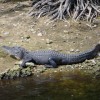 Florida has two native species of crocodilians, the American alligator and the American crocodile. These federally protected species are easily confused with nonnative crocodilians found in south Florida, such as the spectacled caiman and the Nile crocodile. Some key features used to distinguish these animals are the shape of the head, the shape of the snout, and the pattern of nuchal scutes (bony plates in between head and shoulders). It is important to report all nonnative crocodilians so that researchers may quickly remove them in order to protect Florida’s native ecosystems. This 2-page fact sheet was written by Michiko A. Squires, Seth C. Farris, Brian M. Jeffery, and Frank J. Mazzotti, and published by the UF Department of Wildlife Ecology and Conservation, September 2013.
Florida has two native species of crocodilians, the American alligator and the American crocodile. These federally protected species are easily confused with nonnative crocodilians found in south Florida, such as the spectacled caiman and the Nile crocodile. Some key features used to distinguish these animals are the shape of the head, the shape of the snout, and the pattern of nuchal scutes (bony plates in between head and shoulders). It is important to report all nonnative crocodilians so that researchers may quickly remove them in order to protect Florida’s native ecosystems. This 2-page fact sheet was written by Michiko A. Squires, Seth C. Farris, Brian M. Jeffery, and Frank J. Mazzotti, and published by the UF Department of Wildlife Ecology and Conservation, September 2013.
http://edis.ifas.ufl.edu/uw380
Healthy Eating: Food Storage Guide
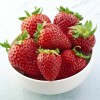 If you don’t shop for groceries often, you may want to buy food that will last until your next trip to the store. The following storage guidelines for perishable foods will help you decide how much food to buy when you visit the grocery. Keep in mind that safe storage times depend on the condition of the food when you purchase it and your refrigerator temperature and humidity. Check foods often for any signs of spoilage. This 2-page fact sheet was written by Linda B. Bobroff and Jennifer Hillan, and published by the UF Department of Family Youth and Community Sciences, October 2013.
If you don’t shop for groceries often, you may want to buy food that will last until your next trip to the store. The following storage guidelines for perishable foods will help you decide how much food to buy when you visit the grocery. Keep in mind that safe storage times depend on the condition of the food when you purchase it and your refrigerator temperature and humidity. Check foods often for any signs of spoilage. This 2-page fact sheet was written by Linda B. Bobroff and Jennifer Hillan, and published by the UF Department of Family Youth and Community Sciences, October 2013.
http://edis.ifas.ufl.edu/fy699